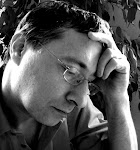I’d heard a little about the course already. I knew it was interdisciplinary, taking components of computing, writing, design etc and allowing the students a fair bit of freedom to shape the course to match their own interests. They graduate with either an MA or an MSc, depending on the bias of their work.
But that knowledge was all abstract. I had no idea what a showcase of students’ work would physically look like.
Without describing each piece in detail there is no way to sum up what I saw beyond saying it does exactly what it says on the tin. Creative technology. Here are two examples:
First Rhys Davis – whose name you may have seen in connection with the Zombie Undead film, of which he is the director. On first sight, his exhibit seemed to be a large screen on which were projected the silhouettes of flocks of flying birds. But when I stepped up to it, I found a kind of shadow of myself on the screen – in purple – under which the birds tended to congregate.
“It’s just a game, really,” Rhys confided apologetically. “A toy.” No need to apologise. I stood there watching the movement and the interaction, fascinated by the way the birds followed me as I shifted across the screen. I loved it. I could have stood there for hours, but there was a queue of other people waiting to have a go.

Second, Paul Found, who had started his project by asking a synesthetic question: “What shape is red?”
Synesthesia is a hardwired crossover of senses in the brain with which a small percentage of people are born. Taste to colour, perhaps. Shape to sound. It seems to be quite individual and different for each person. My daughter has this to some degree, having colours and shapes associated with words, numbers, times, objects and people.
Paul Found, a non-synesthetic – approached the question logically, taking the three numbers of the RBG system associated with each colour and using them to construct a three dimensional graph – which he then created using a three dimensional printer. It all sounded very high-tech to me. Although in finishing his colour models he had to resort to paint spray, car polish and elbow grease.

There was no suggestion that any synesthetic would agree with his colour to shape maps – indeed it would have told us something unexpected and fascinating about the brain had they done so. But the objects he created were undoubtedly beautiful and wonderfully tactile. I showed my daughter photographs of his red model and she pulled a face. "That's just weird," she said. "That's not red. Red is 2 dimensional."
The exhibition gave the impression that a group of intelligent and talented individuals had been given a room full of high tech toys and told to play for a few months. In the present economic climate that might seem to be a strange luxury.
But I found the results of their work enjoyable and stimulating. The world would be a far poorer place without them.

6 comments:
A 3d printer? That I'd like to see. Sounds like a fascinating exbo.
Fascinating. Love the sound of Rhys's interactive birds game in particular. Think I want one of those :-)
Hi Niki - the way he described it, it is like an ink jet printer with an extra dimension. It shoots out a material that solidifies into the 3D form you are making.
Remember the scene in The Fifth Element where they reconstruct Leeloo in a machine - I imagine it that!
Rod
Hi Katy,
I'm seeing Rhys tonight to talk about a film treatment we are developing. I'll tell him you want one. :-)
Rod
I have a touch of synesthesia. I can tell you with confidence what the color of each letter of the alphabet is. (I've known other people who can do the same, though they get all of the colors "wrong.") I can also see the shapes of sounds, especially when listening to symphonic music.
Most of us like this don't feel the slightest bit special. It's surprising when others confess that they don't have the same experiences. To me it is as though everyone sees only black and white and have no idea that there might be color in the world.
I'd read somewhere that one researcher went as far as declaring that synasthetes invented metaphor. I think that's a bit of an overstatement, but there is supposed to be a list of famous writers who enjoyed the condition. Nabokov was one, if I recall correctly.
That's really interesting. Thanks.
I remember the moment I realised other people don't perceive space in the way that I do. I guess the default state is the assumption that other people think in the same way we do.
Post a Comment